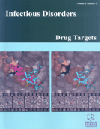-
oa Editorial [Hot Topic: RSV Research is Now Close to Providing Solutions to RSV Infection (Guest Editors: Reena Ghildyal and John Mills)]
- Source: Infectious Disorders - Drug Targets (Formerly Current Drug Targets - Infectious Disorders), Volume 12, Issue 2, Apr 2012, p. 91 - 91
-
- 01 Apr 2012
Abstract
The discovery of respiratory syncytial virus and the connection between RSV infection and severe respiratory disease in children was made over a half-century ago by Bob Chanock and his colleagues. In the intervening decades it has become clear that RSV is a major respiratory pathogen – nearly equal or second only to influenza virus – of infants, children, adults, the elderly and immunosuppressed individuals of all ages. If the reader had any doubts about the clinical and public health importance of RSV infection, the manuscripts in this issue by Caroline Breese Hall, Edward Walsh and Anne Falsey would certainly dispel them. Studies reviewed in those papers report rates of complications including hospitalization and death from RSV that are highly significant, and at rates that are about a half or a third of those attributable to influenza. We developed this RSV Theme Issue of Infectious Disorders – Drug Targets because we felt that the time was ripe for an overview of the clinical importance of RSV infection and of the current research on the virus. It is this research which is now close to yielding the tools which will reduce RSV’s clinical importance through developing effective vaccines and chemotherapeutic agents. Development of vaccines to prevent or mitigate RSV infection began shortly after its discovery, but research virtually came to a halt for several decades after a large clinical trial of a formalin-inactivated whole-virus vaccine paradoxically worsened the disease (see Costello et al., paper in this issue for details). Over the past 15-20 years attempts have been made to develop liveattenuated vaccines for infants as well as protein-based vaccines for adults, and research has also at least partially elucidated the reasons for the paradoxical effects of the formalin-inactivated vaccine. The wide availability of a reverse genetics system for RSV has facilitated generation of attenuated variants, and will continue to do so. So far, these efforts have not been completely successful, with many candidate RSV vaccines failing because of an inability to achieve the required level of safety whilst retaining efficacy. However, the success of the neutralizing F protein monoclonal antibody, palivizumab, for passive immunoprophylaxis clearly shows that vaccines which generate protective antibodies will be effective. It is unfortunate that motavizumab, also developed by Medimmune/AstraZeneca, and which appeared more potent than palivizumab in vitro and in clinical trials, was dropped by AstraZeneca when the FDA expressed concerns about adverse reactions and other issues and requested additional clinical trials. Previous and ongoing work has clearly shown that attenuation through mutation of single genes, though effective in reducing RSV infection and spread, all too easily allows reversion to wild-type virus. A combination of mutations that inhibit several different stages in the RSV lifecycle without reducing its immunogenicity, we think, is a better approach. A major challenge for any RSV vaccine is the requirement that it be safe and immunogenic in infants and the elderly; two extremes of age where immune systems do not function optimally. Given the additional complication in infants of the presence of maternal antibodies, it is probable that two different vaccine formulations will need to be developed. This has been highlighted in recent trials with live attenuated candidates showing that strains attenuated in adults and RSV-seropositive children may not be similarly attenuated in infants. The multiplicity of additional attenuating mutations that come from an understanding of the function of the non-structural proteins and the matrix protein – discussed in the articles by Teng and Ghildyal et al., in this issue, combined with other approaches such as the use of recombinant vectors for antigen delivery – we think will result in successful attenuated vaccines suitable for use even in infants. Although some may disagree, our opinion is that we do not have an effective therapeutic for RSV infections. Ribavirin is FDA-approved for that indication, but the data supporting its efficacy would not allow approval by current standards, and it is rarely used by clinicians. Clearly better drugs are needed. Again, data reported in this Theme Issue indicate that there are many processes in the RSV replication cycle which could be targeted by novel antiviral drugs. Several drugs have been developed against the F protein which showed some efficacy in animal studies, but their development was discontinued because of toxicity and/or insufficient efficacy. The approval of the peptide antiviral enfuvirtide for treatment of HIV infection, despite its limitations of cost, the need for parenteral administration and toxicity, has shown that clinically-effective fusion inhibitors can be developed, and this success should spur commercial interest. Work by Costello et al., summarized in this issue, also supports development of an RSV F protein inhibitor. However, a myriad other targets are also worthy of development. Maybe it is time to adopt a multidrug / multifaceted approach to RSV, on the lines of the very successful multidrug therapy for HIV. A famous Roz Chast cartoon published in The New Yorker magazine many years ago shows four panels, and in each panel there is a person staring at a half-full glass of water on a table. In the first panel the person says, “half full – that’s great”; in the second, “half-full – that’s terrible”; in the third, “half-full; half-empty; I can’t make up my mind” and in the fourth he says, “what’s this? I ordered a Big Mac and a Coke”. Perhaps this cartoon reflects the RSV drug and vaccine landscape!


